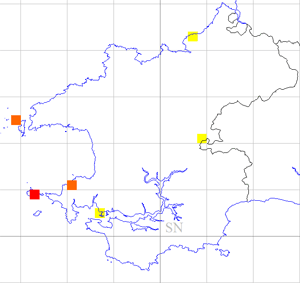Little Owls are found in open lowland country; they often perch in quite prominent positions close to nest sites and so are not quite as difficult to census, compared with the larger owls. According to Donovan and Rees (1994) Little Owls were thought to be increasing again following a gradual decline in the middle part of the 20th Century.
Recent data suggest that there has clearly been a significant crash in their population during the years between 1984-88 and 2003-07. During the earlier atlas period, Little Owls were recorded in 31 tetrads, but from only six tetrads during 2003-07, an 81% decline. All atlas categories registered fairly large declines.
Donovan and Rees (1994) estimated that there were probably 50 pairs breeding in Pembrokeshire in the 1980s. During the recent atlas period, breeding was confirmed only on Skomer Island and on Ramsey Island. On the Pembrokeshire mainland they were recorded at just a thin scattering of widely distributed locations where breeding was not proven.
Although this is an introduced species to Britain, first recorded in Pembrokeshire at Solva in 1920 (Donovan and Rees, 1994), the Little Owl is now one of our rarest breeding species. Judging by the latest distribution maps, it would appear to be one we could lose, at least on the Pembrokeshire mainland.
Bob Haycock

Fieldwork 2003-07 (based on 490 tetrads)
Red = breeding confirmed = 1
Orange = breeding probable = 2
Yellow = breeding possible = 3
Total tetrads in which registered = 6 (1.2%)
 Monday, August 26, 2013 at 10:36AM
Monday, August 26, 2013 at 10:36AM  1949 BoP in
1949 BoP in  Little Owl
Little Owl 





